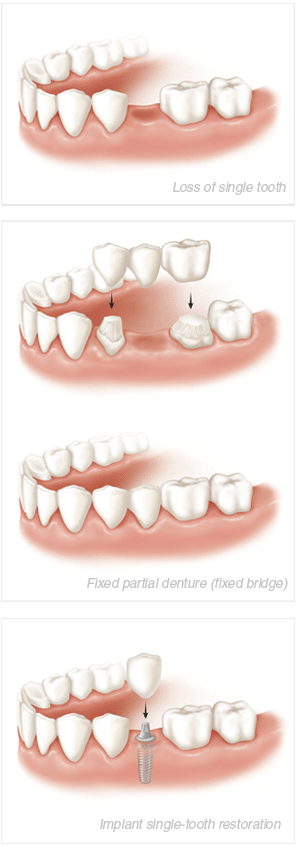Replacing a Single Tooth

Replacing a single tooth can be achieved with a conventional bridge or an implant retained crown.
The conventional fixed partial denture (fixed bridge) requires that your dentist drills down two or more adjacent teeth to create space for the crowns of the prosthetic teeth. Placing a bridge on natural teeth increases the functional forces that are placed upon them and makes the use of floss between the teeth more difficult. Conventional bridges may need to be replaced if the supporting teeth develop cavities or periodontal disease. In a certain percentage of instances while preparing the adjacent teeth for crowns (i.e. drilling down a tooth), the preparatory procedure will cause the nerve of the tooth to die and require root canal treatment to eliminate infection of the nerve.
 An implant single-tooth restoration avoids the need to restore the adjacent teeth and also replaces the support that is lost with the missing tooth. This allows normal flossing as if the replacement implant were a natural tooth. An implant is placed in the position of the missing tooth. When the implant is stable and ready for loading, an abutment can be attached to the implant that will connect the final crown to the implant. An impression is made to record the contours of the abutment or the position of the implant top. The crown is then fabricated and fixed in place using cement or screws. An implant crown is not susceptible to cavities but may develop complications if oral hygiene is not maintained. The implant restoration should be routinely evaluated in time intervals that are determined by the conditions of the remaining natural teeth and the implant.
An implant single-tooth restoration avoids the need to restore the adjacent teeth and also replaces the support that is lost with the missing tooth. This allows normal flossing as if the replacement implant were a natural tooth. An implant is placed in the position of the missing tooth. When the implant is stable and ready for loading, an abutment can be attached to the implant that will connect the final crown to the implant. An impression is made to record the contours of the abutment or the position of the implant top. The crown is then fabricated and fixed in place using cement or screws. An implant crown is not susceptible to cavities but may develop complications if oral hygiene is not maintained. The implant restoration should be routinely evaluated in time intervals that are determined by the conditions of the remaining natural teeth and the implant.




